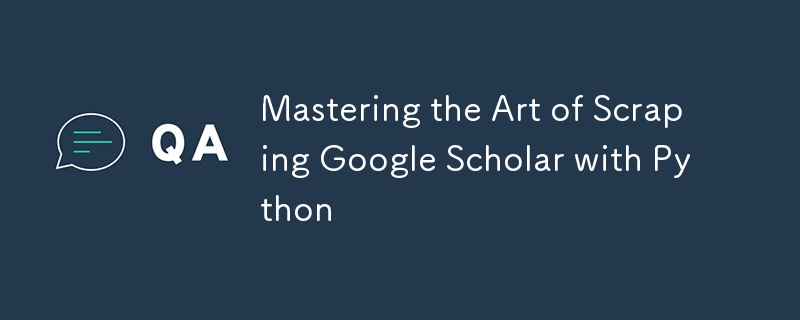掌握使用 Python 抓取 Google Scholar 的艺术

如果您正在深入进行学术研究或数据分析,您可能会发现自己需要来自 Google 学术搜索的数据。不幸的是,没有官方的 Google Scholar API Python 支持,这使得提取这些数据有点棘手。然而,凭借正确的工具和知识,您可以有效地抓取 Google Scholar。在这篇文章中,我们将探讨抓取 Google Scholar 的最佳实践、您需要的工具,以及为什么 Oxylabs 脱颖而出成为推荐的解决方案。
什么是谷歌学术?
Google Scholar 是一个可免费访问的网络搜索引擎,可以对一系列出版格式和学科的学术文献的全文或元数据进行索引。它允许用户搜索文章的数字或物理副本,无论是在线还是在图书馆。欲了解更多信息,您可以访问谷歌学术。
为什么要抓取谷歌学术?
抓取 Google Scholar 可以带来很多好处,包括:
- 数据收集:收集用于学术研究或数据分析的大型数据集。
- 趋势分析:监控特定研究领域的趋势。
- 引文跟踪:跟踪特定文章或作者的引文。
但是,在抓取时考虑道德准则和 Google 的服务条款至关重要。始终确保您的抓取活动受到尊重且合法。
先决条件
在深入研究代码之前,您需要以下工具和库:
- Python:我们将使用的编程语言。
- BeautifulSoup:用于解析 HTML 和 XML 文档的库。
- Requests:用于发出 HTTP 请求的库。
您可以在这里找到这些工具的官方文档:
- Python
- 美丽汤
- 请求
设置您的环境
首先,确保您已经安装了Python。您可以从Python官方网站下载它。接下来,使用 pip 安装必要的库:
pip install beautifulsoup4 requests
这是一个用于验证您的设置的简单脚本:
import requests from bs4 import BeautifulSoup url = "https://scholar.google.com/" response = requests.get(url) soup = BeautifulSoup(response.text, 'html.parser') print(soup.title.text)
此脚本获取 Google Scholar 主页并打印页面标题。
基本刮擦技术
网页抓取涉及获取网页内容并提取有用信息。这是抓取 Google Scholar 的基本示例:
import requests
from bs4 import BeautifulSoup
def scrape_google_scholar(query):
url = f"https://scholar.google.com/scholar?q={query}"
response = requests.get(url)
soup = BeautifulSoup(response.text, 'html.parser')
for item in soup.select('[data-lid]'):
title = item.select_one('.gs_rt').text
snippet = item.select_one('.gs_rs').text
print(f"Title: {title}\nSnippet: {snippet}\n")
scrape_google_scholar("machine learning")
此脚本在 Google Scholar 上搜索“机器学习”并打印结果的标题和片段。
先进的刮擦技术
处理分页
Google 学术搜索结果已分页。要抓取多个页面,需要处理分页:
def scrape_multiple_pages(query, num_pages):
for page in range(num_pages):
url = f"https://scholar.google.com/scholar?start={page*10}&q={query}"
response = requests.get(url)
soup = BeautifulSoup(response.text, 'html.parser')
for item in soup.select('[data-lid]'):
title = item.select_one('.gs_rt').text
snippet = item.select_one('.gs_rs').text
print(f"Title: {title}\nSnippet: {snippet}\n")
scrape_multiple_pages("machine learning", 3)
处理验证码和使用代理
Google Scholar 可能会提供验证码以防止自动访问。使用代理可以帮助缓解这种情况:
proxies = {
"http": "http://your_proxy_here",
"https": "https://your_proxy_here",
}
response = requests.get(url, proxies=proxies)
要获得更强大的解决方案,请考虑使用 Oxylabs 等服务来管理代理并避免验证码。
错误处理和故障排除
网络抓取可能会遇到各种问题,例如网络错误或网站结构的变化。以下是处理常见错误的方法:
try:
response = requests.get(url)
response.raise_for_status()
except requests.exceptions.HTTPError as err:
print(f"HTTP error occurred: {err}")
except Exception as err:
print(f"An error occurred: {err}")
网页抓取的最佳实践
- 道德抓取:始终尊重网站的 robots.txt 文件和服务条款。
- 速率限制:避免在短时间内发送太多请求。
- 数据存储:负责任且安全地存储抓取的数据。
有关道德抓取的更多信息,请访问 robots.txt。
案例研究:实际应用
让我们考虑一个现实世界的应用程序,我们在其中抓取 Google Scholar 来分析机器学习研究的趋势:
import pandas as pd
def scrape_and_analyze(query, num_pages):
data = []
for page in range(num_pages):
url = f"https://scholar.google.com/scholar?start={page*10}&q={query}"
response = requests.get(url)
soup = BeautifulSoup(response.text, 'html.parser')
for item in soup.select('[data-lid]'):
title = item.select_one('.gs_rt').text
snippet = item.select_one('.gs_rs').text
data.append({"Title": title, "Snippet": snippet})
df = pd.DataFrame(data)
print(df.head())
scrape_and_analyze("machine learning", 3)
此脚本会抓取多页 Google Scholar 搜索结果并将数据存储在 Pandas DataFrame 中以供进一步分析。
常见问题解答
如何使用 Python 抓取 Google Scholar?
您可以使用 BeautifulSoup 和 Requests 等库来抓取 Google Scholar。请按照本指南中概述的步骤进行详细演练。
哪些图书馆最适合抓取 Google Scholar?
BeautifulSoup 和 Requests 通常用于 Python 中的网页抓取。对于更高级的需求,请考虑使用 Scrapy 或 Selenium。
抓取 Google Scholar 是否合法?
抓取 Google 学术搜索可能违反 Google 的服务条款。请务必检查网站的条款和条件并负责任地使用抓取。
抓取 Google Scholar 时如何处理验证码?
使用代理和轮换用户代理会有所帮助。如需更强大的解决方案,请考虑使用 Oxylabs 等服务。
结论
使用 Python 抓取 Google Scholar 可以解锁大量数据用于研究和分析。通过遵循本指南中概述的步骤和最佳实践,您可以有效且合乎道德地抓取 Google Scholar。
-
 如何处理PHP文件系统功能中的UTF-8文件名?在PHP的Filesystem functions中处理UTF-8 FileNames 在使用PHP的MKDIR函数中含有UTF-8字符的文件很多flusf-8字符时,您可能会在Windows Explorer中遇到comploreer grounder grounder grounder gro...编程 发布于2025-07-14
如何处理PHP文件系统功能中的UTF-8文件名?在PHP的Filesystem functions中处理UTF-8 FileNames 在使用PHP的MKDIR函数中含有UTF-8字符的文件很多flusf-8字符时,您可能会在Windows Explorer中遇到comploreer grounder grounder grounder gro...编程 发布于2025-07-14 -
 C++成员函数指针正确传递方法如何将成员函数置于c [&& && && && && && && && && && &&&&&&&&&&&&&&&&&&&&&&&华仪的函数时,在接受成员函数指针的函数时,要在函数上既要提供指针又可以提供指针和指针到函数的函数。需要具有一定签名的功能指针。要通过成员函数,您需要同时提供对象指针(此...编程 发布于2025-07-14
C++成员函数指针正确传递方法如何将成员函数置于c [&& && && && && && && && && && &&&&&&&&&&&&&&&&&&&&&&&华仪的函数时,在接受成员函数指针的函数时,要在函数上既要提供指针又可以提供指针和指针到函数的函数。需要具有一定签名的功能指针。要通过成员函数,您需要同时提供对象指针(此...编程 发布于2025-07-14 -
 编译器报错“usr/bin/ld: cannot find -l”解决方法错误:“ usr/bin/ld:找不到-l “ 此错误表明链接器在链接您的可执行文件时无法找到指定的库。为了解决此问题,我们将深入研究如何指定库路径并将链接引导到正确位置的详细信息。添加库搜索路径的一个可能的原因是,此错误是您的makefile中缺少库搜索路径。要解决它,您可以在链接器命令中添加...编程 发布于2025-07-14
编译器报错“usr/bin/ld: cannot find -l”解决方法错误:“ usr/bin/ld:找不到-l “ 此错误表明链接器在链接您的可执行文件时无法找到指定的库。为了解决此问题,我们将深入研究如何指定库路径并将链接引导到正确位置的详细信息。添加库搜索路径的一个可能的原因是,此错误是您的makefile中缺少库搜索路径。要解决它,您可以在链接器命令中添加...编程 发布于2025-07-14 -
 如何检查对象是否具有Python中的特定属性?方法来确定对象属性存在寻求一种方法来验证对象中特定属性的存在。考虑以下示例,其中尝试访问不确定属性会引起错误: >>> a = someClass() >>> A.property Trackback(最近的最新电话): 文件“ ”,第1行, attributeError:SomeClass实...编程 发布于2025-07-14
如何检查对象是否具有Python中的特定属性?方法来确定对象属性存在寻求一种方法来验证对象中特定属性的存在。考虑以下示例,其中尝试访问不确定属性会引起错误: >>> a = someClass() >>> A.property Trackback(最近的最新电话): 文件“ ”,第1行, attributeError:SomeClass实...编程 发布于2025-07-14 -
 C++20 Consteval函数中模板参数能否依赖于函数参数?[ consteval函数和模板参数依赖于函数参数在C 17中,模板参数不能依赖一个函数参数,因为编译器仍然需要对非contexexpr futcoriations contim at contexpr function进行评估。 compile time。 C 20引入恒定函数,必须在编译时进行...编程 发布于2025-07-14
C++20 Consteval函数中模板参数能否依赖于函数参数?[ consteval函数和模板参数依赖于函数参数在C 17中,模板参数不能依赖一个函数参数,因为编译器仍然需要对非contexexpr futcoriations contim at contexpr function进行评估。 compile time。 C 20引入恒定函数,必须在编译时进行...编程 发布于2025-07-14 -
 Go语言如何动态发现导出包类型?与反射软件包中的有限类型的发现能力相反,本文探讨了在运行时发现所有包装类型(尤其是struntime go import( “ FMT” “去/进口商” ) func main(){ pkg,err:= incorter.default()。导入(“ time”) ...编程 发布于2025-07-14
Go语言如何动态发现导出包类型?与反射软件包中的有限类型的发现能力相反,本文探讨了在运行时发现所有包装类型(尤其是struntime go import( “ FMT” “去/进口商” ) func main(){ pkg,err:= incorter.default()。导入(“ time”) ...编程 发布于2025-07-14 -
 Go语言垃圾回收如何处理切片内存?Garbage Collection in Go Slices: A Detailed AnalysisIn Go, a slice is a dynamic array that references an underlying array.使用切片时,了解垃圾收集行为至关重要,以避免潜在的内存泄...编程 发布于2025-07-14
Go语言垃圾回收如何处理切片内存?Garbage Collection in Go Slices: A Detailed AnalysisIn Go, a slice is a dynamic array that references an underlying array.使用切片时,了解垃圾收集行为至关重要,以避免潜在的内存泄...编程 发布于2025-07-14 -
 CSS可以根据任何属性值来定位HTML元素吗?靶向html元素,在CSS 中使用任何属性值,在CSS中,可以基于特定属性(如下所示)基于特定属性的基于特定属性的emants目标元素: 字体家庭:康斯拉斯(Consolas); } 但是,出现一个常见的问题:元素可以根据任何属性值而定位吗?本文探讨了此主题。的目标元素有任何任何属性值,属...编程 发布于2025-07-14
CSS可以根据任何属性值来定位HTML元素吗?靶向html元素,在CSS 中使用任何属性值,在CSS中,可以基于特定属性(如下所示)基于特定属性的基于特定属性的emants目标元素: 字体家庭:康斯拉斯(Consolas); } 但是,出现一个常见的问题:元素可以根据任何属性值而定位吗?本文探讨了此主题。的目标元素有任何任何属性值,属...编程 发布于2025-07-14 -
 如何将MySQL数据库添加到Visual Studio 2012中的数据源对话框中?在Visual Studio 2012 尽管已安装了MySQL Connector v.6.5.4,但无法将MySQL数据库添加到实体框架的“ DataSource对话框”中。为了解决这一问题,至关重要的是要了解MySQL连接器v.6.5.5及以后的6.6.x版本将提供MySQL的官方Visual...编程 发布于2025-07-14
如何将MySQL数据库添加到Visual Studio 2012中的数据源对话框中?在Visual Studio 2012 尽管已安装了MySQL Connector v.6.5.4,但无法将MySQL数据库添加到实体框架的“ DataSource对话框”中。为了解决这一问题,至关重要的是要了解MySQL连接器v.6.5.5及以后的6.6.x版本将提供MySQL的官方Visual...编程 发布于2025-07-14 -
 可以在纯CS中将多个粘性元素彼此堆叠在一起吗?[2这里: https://webthemez.com/demo/sticky-multi-header-scroll/index.html </main> <section> { display:grid; grid-template-...编程 发布于2025-07-14
可以在纯CS中将多个粘性元素彼此堆叠在一起吗?[2这里: https://webthemez.com/demo/sticky-multi-header-scroll/index.html </main> <section> { display:grid; grid-template-...编程 发布于2025-07-14 -
 如何解决AppEngine中“无法猜测文件类型,使用application/octet-stream...”错误?appEngine静态文件mime type override ,静态文件处理程序有时可以覆盖正确的mime类型,在错误消息中导致错误消息:“无法猜测mimeType for for file for file for [File]。 application/application/octet...编程 发布于2025-07-14
如何解决AppEngine中“无法猜测文件类型,使用application/octet-stream...”错误?appEngine静态文件mime type override ,静态文件处理程序有时可以覆盖正确的mime类型,在错误消息中导致错误消息:“无法猜测mimeType for for file for file for [File]。 application/application/octet...编程 发布于2025-07-14 -
 CSS强类型语言解析您可以通过其强度或弱输入的方式对编程语言进行分类的方式之一。在这里,“键入”意味着是否在编译时已知变量。一个例子是一个场景,将整数(1)添加到包含整数(“ 1”)的字符串: result = 1 "1";包含整数的字符串可能是由带有许多运动部件的复杂逻辑套件无意间生成的。它也可以是故意从单个真理...编程 发布于2025-07-14
CSS强类型语言解析您可以通过其强度或弱输入的方式对编程语言进行分类的方式之一。在这里,“键入”意味着是否在编译时已知变量。一个例子是一个场景,将整数(1)添加到包含整数(“ 1”)的字符串: result = 1 "1";包含整数的字符串可能是由带有许多运动部件的复杂逻辑套件无意间生成的。它也可以是故意从单个真理...编程 发布于2025-07-14 -
 `console.log`显示修改后对象值异常的原因foo = [{id:1},{id:2},{id:3},{id:4},{id:id:5},],]; console.log('foo1',foo,foo.length); foo.splice(2,1); console.log('foo2', foo, foo....编程 发布于2025-07-14
`console.log`显示修改后对象值异常的原因foo = [{id:1},{id:2},{id:3},{id:4},{id:id:5},],]; console.log('foo1',foo,foo.length); foo.splice(2,1); console.log('foo2', foo, foo....编程 发布于2025-07-14 -
 如何使用不同数量列的联合数据库表?合并列数不同的表 当尝试合并列数不同的数据库表时,可能会遇到挑战。一种直接的方法是在列数较少的表中,为缺失的列追加空值。 例如,考虑两个表,表 A 和表 B,其中表 A 的列数多于表 B。为了合并这些表,同时处理表 B 中缺失的列,请按照以下步骤操作: 确定表 B 中缺失的列,并将它们添加到表的末...编程 发布于2025-07-14
如何使用不同数量列的联合数据库表?合并列数不同的表 当尝试合并列数不同的数据库表时,可能会遇到挑战。一种直接的方法是在列数较少的表中,为缺失的列追加空值。 例如,考虑两个表,表 A 和表 B,其中表 A 的列数多于表 B。为了合并这些表,同时处理表 B 中缺失的列,请按照以下步骤操作: 确定表 B 中缺失的列,并将它们添加到表的末...编程 发布于2025-07-14
学习中文
- 1 走路用中文怎么说?走路中文发音,走路中文学习
- 2 坐飞机用中文怎么说?坐飞机中文发音,坐飞机中文学习
- 3 坐火车用中文怎么说?坐火车中文发音,坐火车中文学习
- 4 坐车用中文怎么说?坐车中文发音,坐车中文学习
- 5 开车用中文怎么说?开车中文发音,开车中文学习
- 6 游泳用中文怎么说?游泳中文发音,游泳中文学习
- 7 骑自行车用中文怎么说?骑自行车中文发音,骑自行车中文学习
- 8 你好用中文怎么说?你好中文发音,你好中文学习
- 9 谢谢用中文怎么说?谢谢中文发音,谢谢中文学习
- 10 How to say goodbye in Chinese? 再见Chinese pronunciation, 再见Chinese learning

























